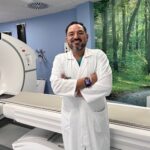
February 21 – 13:30 – 14:30 CET
Neuroendocrine tumours (NETs) are a rare but clinically significant group of malignancies arising from neuroendocrine cells, often presenting in the gastrointestinal tract or lungs. While NETs account for a small fraction of overall cancer cases, their incidence is steadily rising. Radioguided surgery has emerged as a highly effective approach for treating NETs, particularly in cases of primary tumours or oligometastatic disease, where nuclear medicine imaging precisely localizes the lesions and surgical resection is feasible.
This session will explore the current landscape of radioguided surgery, with a specific focus on
neuroendocrine tumour applications. We will begin by reviewing the latest tracers and instrumentation employed in radioguided procedures, discussing their mechanisms, advantages, and limitations. Following this, we will delve into the clinical integration of these tracers and devices, examining their role in the routine surgical workflow for NETs. By highlighting the practical implications and clinical outcomes, this session aims to provide attendees with actionable insights into advancing care for patients with neuroendocrine tumours.


